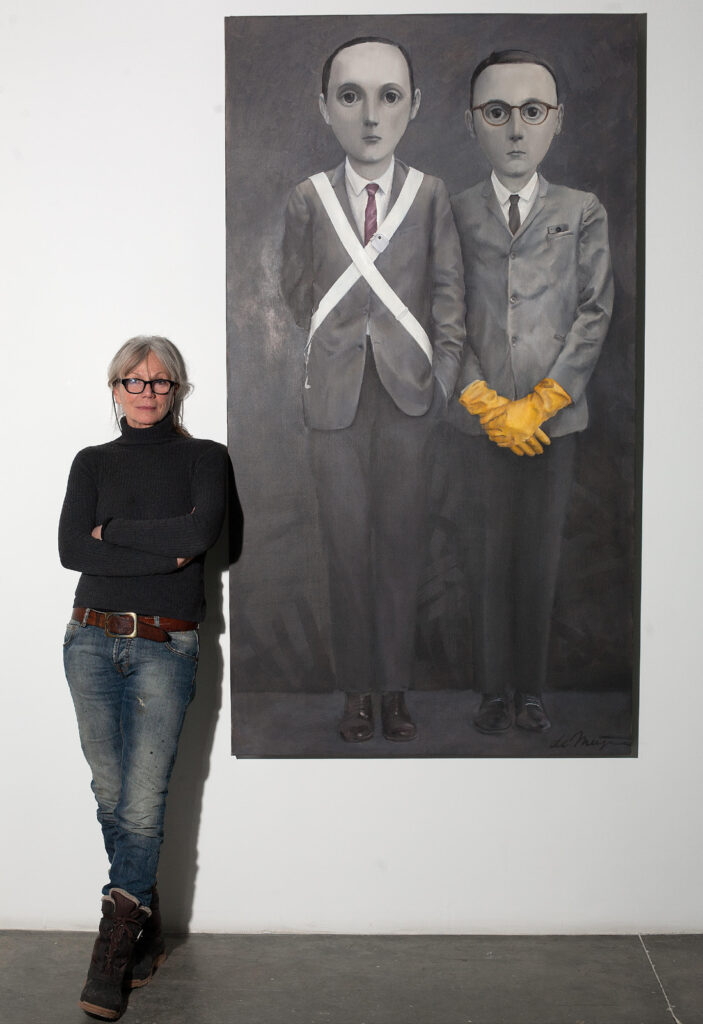
Ellen de Meijer dreams her work—those few grams of gold she had gotten milking time throughout the years—will be someday shown at the MoMA, a modest reachable goal by any standards when she has already achieved something more impressive. The Dutch contemporary artist (Amsterdam, 1955) has established her visual signature and a consistent body of work documenting modern society from a unique perspective using humor and satire to put the most whimsical behaviors that reify and distance us from our most authentic essence under the magnifying glass.
The hardworking artist is patiently and skillfully carving her place in a five-century-long tradition of European social and political satire. She is joining the ranks of Gillray, Hogarth, Cruikshank, Raemaekers, and Daumier, updating their work to reflect modern-day events. She subverts the self-centered nature of portraiture, which traditionally aims to dignify the sitter by showcasing social status, ambitions, and achievements. De Meijer’s approach plays with the classical apagogical argument, using a reductio ad absurdum analytical approach to society, success, and power. Her work portrays her subjects with all their clumsiness and ridiculous dignity, some even depicted in business attire paired with shorts—a combination commonly seen on men’s runways and in designer collections but seemingly out of place in a doctor’s office or stock market trading floor.
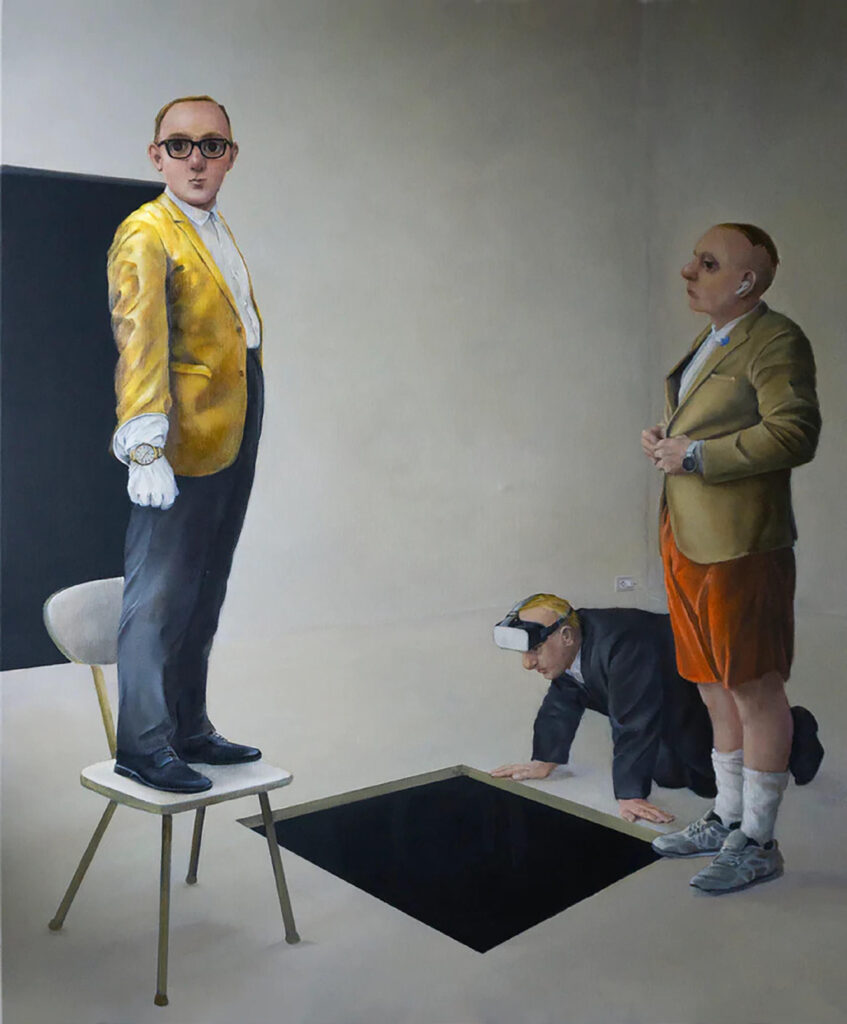
De Meijer’s subjects inhabit liminal and aseptic spaces, evoking a sense of emptiness despite their apparent success. Some pose, while others are captured in their strange daily routines. The sober palette, empty rooms, and the emotionless expressions of the figures draw attention to symbolic details like medals, gold watches, expensive jewelry, and gadgets—the trappings of wealth and success—without detracting from the message. There is something eerie and thought-provoking about her art that encourages reflection rather than mockery, setting de Meijer’s work apart as a profound exploration rather than a mere caricature.
The gravitas that emerges from her paintings prevents us from approaching them as one-glance-reads artworks, revealing that they are pieces of a complex puzzle pursuing to transcend the realm of the temporary occurrence. De Meijer keeps a record of the homo ludens—a term she must be familiar with, coined by her countryman cultural theorist Johan Huizinga—through the homo ludicrous. That’s perhaps why her subjects reveal surprise but not embarrassment while continuing indifferently in their bizarre worlds immersed in their adult playgrounds. Most of her subjects have clone-like unisex features, a next-of-a-kin resemblance, as if they were part of a family gallery of human behaviors.
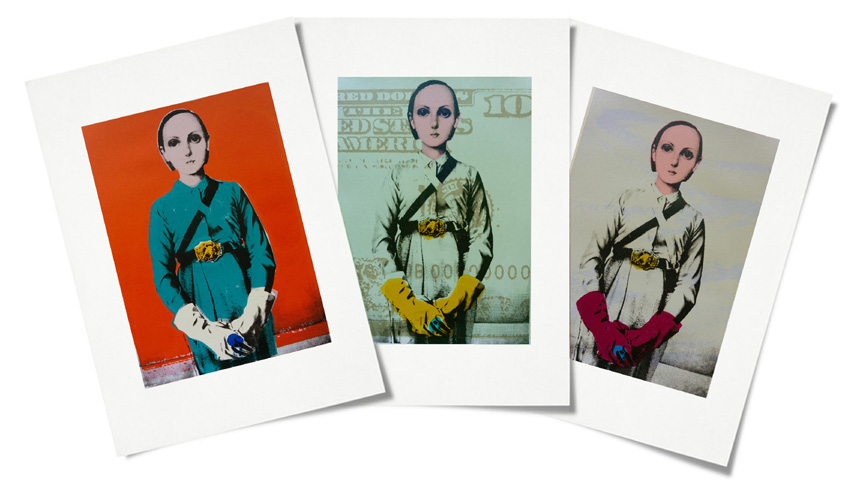
The visual effectiveness and singularity of de Meijer’s satirical approach to social and political issues have not gone unnoticed. Two of her oil on canvas paintings
(Arctic Indictment, 2018; Exposure, 2020) participated in the exhibition “NADA Curated: Reduction to Satire (Reduction ad Satura)” in 2022, curated by London-based independent curator Fatoş Üstek. The exhibition included 27 other works from 20 artists worldwide under the thematic umbrella of ‘reduction to satire’: artists that employ humor, irony, exaggeration, and ridicule to reveal a truth. De Meijer’s work is a prime example of this approach, using satire to shed light on the absurdities of modern life.
The crypto craze, including the mining virtual vicious circle, which is another kind of slavery, the NFT hype, a window to scam naïve artists, and financial speculation, the early adopters of technology, a businessman with toddler arm inflatable floaties oblivious to climate change, the Wall Street bully, the digital debt, the inherited prepotency, the distance between acts and emotions, the dilemma of modern woman professional success and motherhood, they are all legitimate modern challenges that keep awake the Dutch artist, who sleeps little and works intensely. “I only truly sleep on my annual holiday to Greece. I typically sleep 5 hours per night, often ruminating on a painting and thinking about complexities. But in Greece, that’s where I truly surrender to not being a painter. But all the other days, weeks, and months, I paint,” de Meijer says.
De Meijer arrives at her studio at 8:30 am and leaves at 5:00 pm daily. “I recently calculated my hourly rate,” she says. “It sits somewhere between $15 and $20 per hour if I’m lucky, excluding the upfront investment I have to make in buying my materials,” reflects the artist. “I produce about four paintings each year, each taking me an average of three months. The business model of art is not in favor of the artist. Period.”
That is why she—like many other artists frustrated with the unreliability of the traditional career track and encouraged by the opportunities of technology and social media platforms—is taking matters into her own hands. In addition to gallery representation, de Meijer is using a direct-to-consumer revenue model. She is producing her first series of three hand-pressed screen print designs based on the original Lapis Lazuli (2020). Each screen print design is limited to an edition of 50, numbered and signed by the artist.
“As a full-time artist, money is never the primary motivation for creation. But it is a dependency. If you don’t sell work for a period, continuing to buy paint, frames, canvas, brushes, etcetera, costs quickly ramp up,” adds Mick de Meijer, Ellen’s son and managing agent. “That’s why we realized we needed to add another revenue stream. We also wanted to engage with emerging (millennial) art collectors who cannot afford a $20-45k painting yet but are willing to spend from $750 to a few thousand. That’s why we decided to introduce limited edition hand-pressed screen prints based on Ellen’s paintings from her 2011-2021 period. These screen prints are their own artwork, using multiple techniques. From photography and digital manipulation to manual screen printing.”
One of the things that made me smirk in complicity when visiting Ellen de Meijer’s website, beyond the lucidity of her works, is that each one is accompanied by a detailed description that she calls “What we See” and also a witty aphorism she calls “Ellen says.” Those words summarize and open another universe of references beyond the visual puns, showing us that de Meijer is constantly adjusting the sails, finding ways to catch her target, and blowing fireworks in our faces, making us feel uncomfortable, which is the only way to stay alive and true to ourselves when we navigate a world of fakeness.
De Meijer dreams her work will hang on the MoMA’s walls someday. Meanwhile, she hopes it is creating awareness. “Awareness,” she repeats, “and a little change.” G&S
Mick de Meijer
Managing agent of Ellen de Meijer ellendemeijer.com
mick@ellendemeijer.com

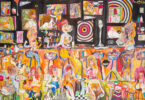

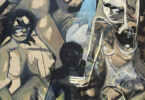

Leave a Comment